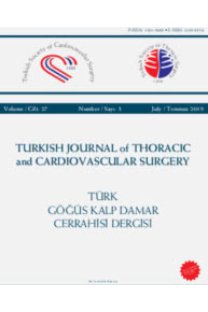Surgical treatment alternatives for occlusive disease of the subclavian artery based on our clinical experience
Klinik deneyimlerimiz eşliğinde subklaviyan arterin tıkayıcı ha stalığında cerrahi tedavi alternatifler
___
- 1.AbuRahma AF, Robinson PA, Jennings TG. Carotid- subclavian bypass grafting with polytetrafluoroethylene grafts for symptomatic subclavian artery stenosis or occlusion: a 20-year experience. J Vasc Surg 2000;32:411-8.
- 2.Takach TJ, Reul GJ Jr, Cooley DA, Livesay JJ, Duncan JM, Ott DA, et al. Concomitant occlusive disease of the coronary arteries and great vessels. Ann Thorac Surg 1998;65:79-84.
- 3.Courbier R, Jausseran JM, Poyen V. Current status of vascular grafting in supraaortic trunks. Personal experience. Int Surg 1988;73:210-2.
- 4.Maggisano R, Provan JL. Surgical management of chronic occlusive disease of the aortic arch vessels and vertebral arteries. Can Med Assoc J 1981;124:972-7.
- 5.Wylie EJ. Surgical treatment of extracranial cerebrovascular disease-introduction. World J Surg 1979;3:145-6.
- 6.Henry M, Amor M, Henry I, Ethevenot G, Tzvetanov K, Chati Z. Percutaneous transluminal angioplasty of the subclavian arteries. J Endovasc Surg 1999;6:33-41.
- 7.Selby JB Jr, Matsumoto AH, Tegtmeyer CJ, Hartwell GD, Tribble CG, Daniel TM, et al. Balloon angioplasty above the aortic arch: immediate and long-term results. AJR Am J Roentgenol 1993;160:631-5.
- 8.Vitti MJ, Thompson BW, Read RC, Gagne PJ, Barone GW, Barnes RW, et al. Carotid-subclavian bypass: a twenty-two- year experience. J Vasc Surg 1994;20:411-7.
- 9.Kretschmer G, Teleky B, Marosi L, Wagner O, Wunderlich M, Karnel F, et al. Obliterations of the proximal subclavian artery: to bypass or to anastomose? J Cardiovasc Surg ( Tor i no) 19 91;32:334 -9.
- 10.Edwards WH Jr, Tapper SS, Edwards WH Sr, Mulherin JL Jr, Martin RS 3rd, Jenkins JM. Subclavian revascularization. A quarter century experience. Ann Surg 1994;219:673-7.
- 11.Salenius JP, Uurto I. Subclavian steal syndrome. Duodecim 2011;127:2148-54. [Abstract]
- 12.Salam TA, Lumsden AB, Smith RB 3rd. Subclavian artery revascularization: a decade of experience with extrathoracic bypass procedures. J Surg Res 1994;56:387-92.
- 13.Branchereau A, Magnan PE, Espinoza H, Bartoli JM. Subclavian artery stenosis: hemodynamic aspects and surgical outcome. J Cardiovasc Surg (Torino) 1991;32:604-12.
- 14.Mingoli A, Feldhaus RJ, Farina C, Schultz RD, Cavallaro A. Comparative results of carotid-subclavian bypass and axillo- axillary bypass in patients with symptomatic subclavian disease. Eur J Vasc Surg 1992;6:26-30.
- 15.AbuRahma AF, Robinson PA, Khan MZ, Khan JH, Boland JP. Brachiocephalic revascularization: a comparison between carotid-subclavian artery bypass and axilloaxillary artery bypass. Surgery 1992;112:84-91.
- 16.Lowell RC, Mills JL. Critical evaluation of axilloaxillary artery bypass for surgical management of symptomatic subclavian and innominate artery occlusive disease. Cardiovasc Surg 1993;1:530-5.
- 17.Hennerici M, Klemm C, Rautenberg W. The subclavian steal phenomenon: a common vascular disorder with rare neurologic deficits. Neurology 1988;38:669-73.
- 18.Farina C, Mingoli A, Schultz RD, Castrucci M, Feldhaus RJ, Rossi P, et al. Percutaneous transluminal angioplasty versus surgery for subclavian artery occlusive disease. Am J Surg 1989;158:511-4.
- 19.Khalil A, Nashef SA. An alternative surgical approach to subclavian and innominate stenosis: a case series. J Cardiothorac Surg 2010;5:73.
- 20.Al-Jundi W, Saleh A, Lawrence K, Choksy S. A case report of coronary-subclavian steal syndrome treated with carotid to axillary artery bypass. Case Report Med 2009;2009:687982.
- 21.Linni K, Ugurluoglu A, Mader N, Hitzl W, Magometschnigg H, Hölzenbein TJ. Endovascular management versus surgery for proximal subclavian artery lesions. Ann Vasc Surg 2008;22:769-75.
- ISSN: 1301-5680
- Yayın Aralığı: 4
- Başlangıç: 1991
- Yayıncı: Bayçınar Tıbbi Yayıncılık
Antioxidant response after the operations for congenital heart diseases
Çağatay ENGİN, Tahir YAĞDI, Ayşenur ATAY, Mehmet KÖSEOĞLU, Figen İŞLETEN, Emrah OĞUZ, M. Fatih AYIK, Yüksel ATAY
Mehmet BOĞA, Erdem ÖZKISACIK, Tünay KURTOĞLU, Çiğdem YENİSEY, Uğur GÜRCÜN, Berent DİŞCİGİL
İki yaşında dilate kardiyomiyopatili olguda ortotopik kalp nakli
Erkan İRİZ, Ayşe ASLAN TANA, Serdar KULA, Rana OLGUNTÜRK, Mehmet Emin ÖZDOĞAN, Tuba DÖNMEZ, Dilek ERER, Yusuf ÜNAL
The effectiveness of transthoracic surgical treatment in elderly patients with esophageal cancer
Atila EROĞLU, Atila TÜRKYILMAZ, Yener AYDIN, Betül GÜNDOĞDU
Giant liposarcoma in hemithorax
Mertol GÖKÇE, Özkan SAYDAM, Remzi ALTIN, Gamze YURDAKAN
Heparine bağlı trombositopeni öyküsü olan bir hastada tekrar ameliyat
Ozan KARAKİŞİ, Erol ŞENER, Levent ÇETİN, Ayşegül KUNT, Mete HIDIROĞLU, Aslıhan KÜÇÜKER
Vein of Galen aneurysm in a newborn baby
Nilgün KÜLTÜRSAY, Füsun ATLIHAN, Mustafa PARILDAR, Şebnem ÇALKAVUR, Vedide TAVLI, Özgür OLUKMAN, Nuh YILMAZ
Bronchoscopic volume reduction in severe emphysema
Çağatay TEZEL, Cemal Asım KUTLU
Koroner baypas ameliyatı sonrası gelişen graft versus host hastalığı
Yavuz FURUNCUOĞLU, Emre ÖZKER, Cihan ŞENGÜL
Halil TÜRKOĞLU, Tufan PAKER, Cihangir ERSOY, Vedat BAYER, Aydın AYTAÇ, Tijen ALKAN, Ahmet ŞAŞMAZEL, Atıf AKÇEVİN
